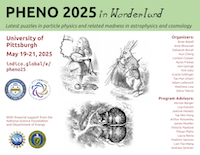Speaker
Description
We present a framework to model microlensing signatures of novel compact object populations beyond the traditional stellar evolution path. A compelling model to investigate is the dissipative dark matter scenario, in particular, the atomic dark matter model, which can form dark black holes (DBHs) from the gravitational collapse of fragmented dark hydrogen gas. DBHs have unique mass ranges and spatial and velocity distributions, distinguishing them from stellar-origin black holes, making them strong candidates for microlensing searches. To estimate their detectability, we rescale results from Population Synthesis for Compact Object Lensing Events (PopSyCLE), which simulates baryonic compact object microlensing events across different surveys, to predict the DBH microlensing signatures. These predictions are then compared to the gravitational wave merger rates of DBH binaries as a function of the fraction of dark matter in DBHs, offering a way to constrain novel populations with multiple gravitational probes.

